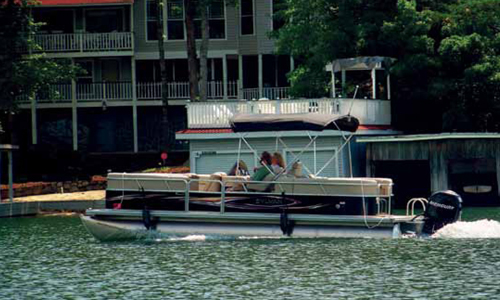Watercraft Safety
Click here to download a PDF of this position statement
 Lake managers invest most of their time, talents and energies making lakes pleasant places to live, work and play. We work to keep water quality nuisances from detracting from everyone’s enjoyment of the lake environment and lake experience. Indeed, we are gratified when lakes are used and enjoyed.
Lake managers invest most of their time, talents and energies making lakes pleasant places to live, work and play. We work to keep water quality nuisances from detracting from everyone’s enjoyment of the lake environment and lake experience. Indeed, we are gratified when lakes are used and enjoyed.
Over the past several decades the popularity of our lakes has increased, resulting in more vessels plying the waters. The greater speeds and maneuverability of modern powerboats and watercraft, combined with renewed interest in paddle sports and other quieter recreation can result in conflicts, presenting a challenge to lake users and managers alike. Those who use and enjoy our lakes share the responsibility to keep them clean and healthy. As well, those who use and enjoy our lakes are also responsible for the safety of themselves and others.
Operator Education, Training & Qualifications
Education – The increased pressures on the nation’s waters have often included recreationists with little prior boating experience. Crowded lakes and the attendant hidden safety and environmental impact concerns inherent to many waters are not the best place to learn the rules of safe boating. Lawmakers throughout the nation are recognizing this, with many states recently implementing mandatory boater education regulations. These efforts are supported by the National Association of State Boating Law Enforcement Agencies (NASBLA) which has developed model ordinances to help guide state and local decision makers.
Training – Mandating boater safety education is an excellent start for ensuring understanding of the ‘rules of the lake’. However, as with automobiles, an integral component of learning to operate vessels safely is the time actually spent running them. The importance of hands-on training has not been ignored by the all-terrain vehicle industry which supports a training academy for new operators, nor on state motor vehicle departments which tend to require road tests for licensing. The unique hazards for safe vessel operation suggest that similar training be made available to new boat operators, and perhaps eventually mandated as courses become more widely available.
Qualifications: Minimum age – The complexity of operating watercraft of all kinds, especially motorized craft, require skills and awareness of one’s surroundings and demands a fair degree of maturity. Therefore a minimum age for operation of powered vessels should be considered. Further, the American Academy of Pediatrics and others, including the Personal Watercraft Industry Association, advocate a minimum operating age of 16 years with required education for personal watercraft (PWC). The nature of PWCs, the speeds used and the close operation of these vessels with other boats, swimmers and obstacles all require a level of mental, emotional and physical maturity not typically found in most young people. Many of us grew up operating boats when we were young and don’t want to deny that opportunity to our own children. Nonetheless, our lakes are more crowded these days with bigger faster boats. It just isn’t safe for younger children to operate PWC and other higher horsepower boats.
Qualifications: Licensing – The concept of requiring a ‘boating license’ is not new, with several states already having implemented them – a trend likely to continue as our waters become more congested. The development of a good licensing program can be a useful way of educating new boaters, and ensuring a greater degree of compliance to boating regulations. The use of boater licensing fees could also provide states with much needed revenue to support increased enforcement – another area of concern to many.
Specific PWC Concerns
The design of PWC is such that in addition to tending to attract individuals interested in more extreme behaviors, lends itself to potentially sever injuries. Since there is no rudder or other features creating drag on the hull, PWCs remain in motion for much greater distances when the throttle is released – without the ability to steer. This has lead to many injuries and some fatalities, especially when inexperienced users have lost control of their vessels, which have then hit swimmers (think 5 year old versus +500 lb machine). The industry is working to correct this – but there is a cost, both financially and performance-wise. So unless is there is continued education and pressure regarding this issue – it is likely to be some time before a suitable solution is found.
Personal watercraft are the only vessels for which blunt force trauma is a more likely to cause death than drowning. This is partly because laws typically require PWC operators to wear personal flotation devices as opposed to merely having them onboard like other boats. However, part of this statistic is also related to the design. The open sides provide no protection during collisions. In addition, the deep foot wells have resulted in injuries to riders in the form of snapped leg bones during sudden or sharp turns. Improved designs may be able to reduce these injuries, and result in safer vessels.
NALMS Positions
- Safe operation of powered watercraft of greater than 15 horsepower requires a significant level of education and experience. Therefore, NALMS supports the efforts of organizations advocating mandatory boater education, and a minimum age of operation for all powered vessels.
- Since the safe operation of PWC requires the same or greater skill, judgment and experience as needed for the safe operation of or cars, NALMS recommends that sixteen be the minimum age of PWC operation.
- NALMS calls upon PWC manufacturers to address unsafe design issues, including off-throttle steering, and lower limb injuries from the deep foot well and lack of protection to riders.
Adopted by the NALMS Board of Directors on [November 7, 2005]
